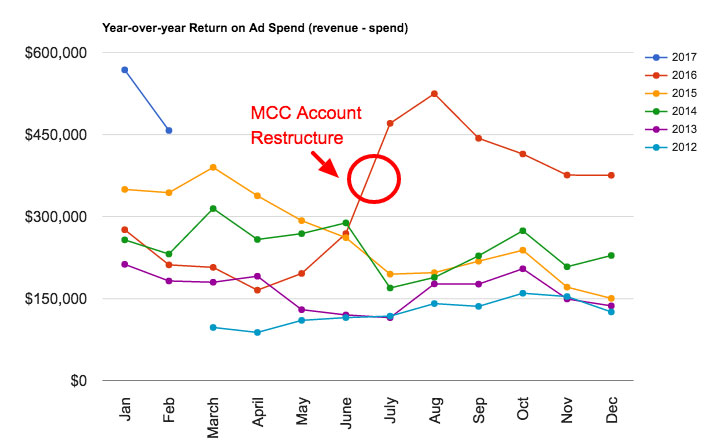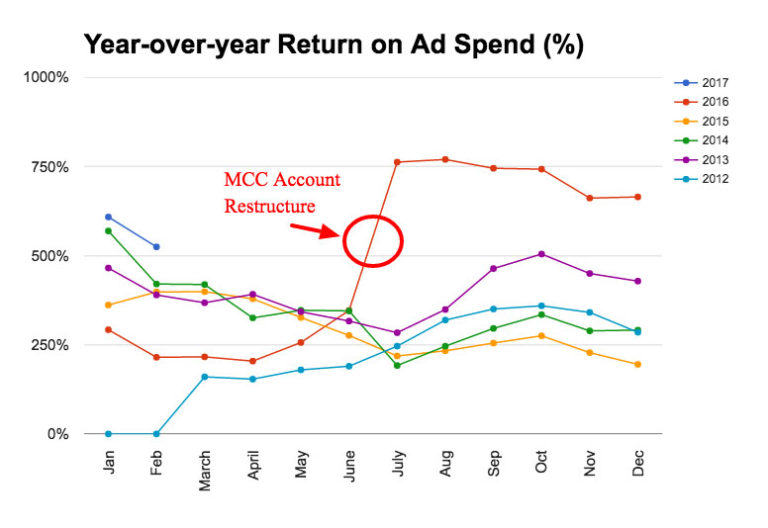Objective:
Our client was utilizing the same Google AdWords account for a period of five years. WTM Digital was managing their account for 4 of those 5 years. Throughout our time with the account, we expanded/rebuilt/and optimized thoroughly – producing consistent year-over-year growth. Given the size of the account and a relatively year-long buying season, there was never a perfect time to perform an account restructure, despite the positive results we were confident would come after the restructure.
Return on Investment results were satisfactory and meeting the client’s goal expectations. However, metrics were plateauing and beginning to decline during Q1 of 2016. Because of the AdWords account structure used at the time, we didn’t have the reporting granularity needed to meet our goals.
WTM Digital, understanding the long term vision of the client, knew that the best thing for the long term health of the account and to prevent revenue erosion was to perform an account restructure.
However, total account restructures are intimidating and risky to implement. Quality Scores and Ad Ranks reset, historical metrics pause, and dozens (if not hundreds) of hours can be used in the rebuilding process.
We had the advantage of working with this particular client for 4 years prior to the restructure, so we fully understood their company, their industry, and every nook and cranny of their AdWords account. This gave us almost complete confidence that a restructure is what was needed – and that it would result in improved metrics across the board.
Strategy:
As stated earlier, the client’s AdWords account was becoming stale, and we were experiencing instances of keyword overlap and duplicate auction entries.
Before we began the restructure, we took a step back and analyzed the client’s organization from a revenue-generating standpoint. We found that there were 11 areas/service lines which made up their primary revenue stream. Each of these areas had their own average order values, monthly goals, and messaging.
To report on each of these 11 areas individually, we decided that creating a new AdWords Manager MCC (parent) account, which housed the 11 sub accounts would allow us to optimize more granularly than ever before – while also being able to report on AdWords performance as a whole.
Their historical AdWords efforts were set up as such:
ACCOUNT STRUCTURE: HISTORICAL LAYOUT

This structure is conducive to setting account-wide goals, and account-wide optimization rules/scripts, which is not what the client needed. Although the overwhelming majority of all AdWords accounts in existence or setup this way – WTM Digital began using a new paid-search philosophy which can be seen in the restructure below:
ACCOUNT STRUCTURE: AFTER WEB TALENT MARKETING RESTRUCTURE

With everything housed under 1 MCC Parent Account, we were able to expand from 94 campaigns to 338 campaigns. At the same time, this allowed us to cut the overall number of keywords in half – to focus on only top performing queries.
So essentially, this restructure allowed for a much wider scope of coverage (thus increasing Search Impression Share and traffic) – while also being extremely granular in our targeting.
Results:
WTM Digital knew that this restructure would improve performance due to the simple fact that we had segmented everything into niche pockets for individual optimization.
But in reality, we didn’t expect the immediate turn-around of revenue growth.
We launched the new restructure while simultaneously pausing the old account. Within 1 week of activation, Return on Ad Spend, Click Through Rate, Search Impression Share, and Conversion Rate (among nearly all other KPIs) began to improve.
Within 30 days, it was clear the volume of hours spent on the restructure was well worth the effort.
We have included charts/graphs below which outline year-over-year performance for the two main KPIs the client is concerned about:
- Return on Ad Spend from a monetary standpoint
- Return on Ad Spend as a percentage
The red line illustrates the decline in revenue we were experiencing during Q1 of 2016. We launched the new account structure mid-June of 2016, illustrated by the circled area of growth – and the subsequent red line of Return on Ad Spend.

Here are the same metrics as above, but shown as a bar graph instead of year-over-year.

Return on Ad Spend calculated as a percentage is shown in the year-over-year line graph below. Results have slowed down a bit since launch, but performance is still the strongest in the client’s history.

Learnings:
Met with slowly eroding sales performance and a lack of granularity required to improve sales performance from the ground up, we embarked upon a complete account restructure in order to achieve long term growth and prevent further performance erosion.
Case Study Highlights
Industry: Office Supplies and Services
Goals:
- Improve return on ad spend (dollars)
- Improve return on ad spend (percentage)
Results:
- Revenue and return on ad spend improved 30 days after new campaign launch
- Improvements in return on ad spend (dollars) and return on ad spend (percentage)
- Increased granularity, increased search impression share, and cleaner data.
